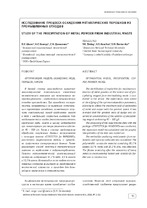| dc.contributor.author | Шелег, В. К. | ru |
| dc.contributor.author | Ковчур, А. С. | ru |
| dc.contributor.author | Денисенко, С. М. | ru |
| dc.coverage.spatial | Витебск | ru |
| dc.date.accessioned | 2020-09-25T07:15:00Z | |
| dc.date.available | 2020-09-25T07:15:00Z | |
| dc.date.issued | 2016 | |
| dc.identifier.citation | Шелег, В. К. Исследование процесса осаждения металлических порошков из промышленных отходов = Study of the precipitation of metal powder from industrial waste / В. К. Шелег, А. С. Ковчур, С. М. Денисенко // Вестник Витебского государственного технологического университета. – 2016. – № 2(31). – С. 91-96. | ru |
| dc.identifier.uri | https://rep.bntu.by/handle/data/79459 | |
| dc.description.abstract | В данной статье производится выявление закономерностей максимального извлечения металлических порошков при минимальных затратах реагента-осадителя из гальванических отходов производства. При проведении экспериментов, направленных на выявление оптимальных параметров осаждения, позволяющих получить максимальный выход карбонатов никеля и меди с наибольшей скоростью, выявлено, что наибольшая масса осадка (максимальная степень извлечения меди, никеля и цинка) наблюдается при концентрации раствора реагента-осадителя 40-100 г/л. Также в статье представлена обработка полученных данных эксперимента с помощью пакета «STATISTICA for WINDOWS», рассчитана регрессионная модель и проведена графическая интерпретация данных. | ru |
| dc.language.iso | ru | ru |
| dc.publisher | ВГТУ | ru |
| dc.title | Исследование процесса осаждения металлических порошков из промышленных отходов | ru |
| dc.title.alternative | Study of the precipitation of metal powder from industrial waste | en |
| dc.type | Article | ru |
| local.description.annotation | The identification of regularities for maximum extraction of metal powders at the lowest cost of precipitating reagent from electroplating waste is conducted in the article. The experiments were aimed at identifying of the optimum deposition parameters, allowing to obtain the maximum yield of carbonates of nickel and copper with the greatest speed. It was revealed that the greatest mass of sludge was observed at concentrations of the solution of precipitating reagent containing 40 – 100 g/l. The processing of the experimental data with the package «STATISTICA for WINDOWS» was conducted, the regression model was calculated and the graphic interpretation of the data was carried out. The method for producing metal powder from carbonates and hydroxy-carbonate was considered. The polymetallic composite material containing 81,2 % copper, 8,5 % nickel and 10,3 % zinc. was obtained. The filtrate remaining after the separation of heavy metals is environmental hazard and suitable for further use in construction. | en |

